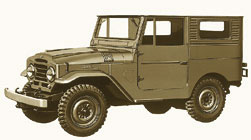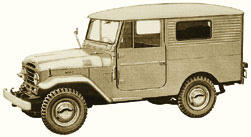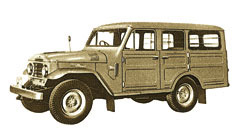During the 50s Toyota Land Cruiser had established itself as a good competitor to Land Rover and Willy Jeep in Japanese market. In 1955, Toyota introduced Model 20 Toyota Land Cruiser for commercial purposes to complement the BJ Series which was more suited to military purposes. Model 20 has softer lines.
The development theme for the 20-series was a new style with more driving comfort. As a result, it didn’t have much in common with the Toyota BJ, instead showing more soft lines in the body styling. These major changes in the chassis frame created a basic design, which through the transition to the 40-series remained unchanged for 29 years.
To improve the riding comfort first the springs in the suspension were changed. The leaf springs in the front and rear were lengthened and the number of plates reduced to 4 to create a softer cushion. In addition, rubber bushings were added to the pivot and shackle in order to dampen the vibration transmitted to the cabin. More vibrations from the suspension would be absorbed rather than transmitted to the body, if the inner channel of the side frame was extended, and the number of closed structure members was increased. The frame itself was strengthened so that the vibrations from the suspension would be absorbed rather than transmitted to the body.
The leaf springs are larger than those on the Toyota BJ, and both pivot and shackle are stronger. The anchor bracket of the leaf spring is fixed to the frame with a rivet. Welding technology at the time was not that reliable.
Along with greater riding comfort, the interior of the vehicle was also made more comfortable. It was larger for one thing, and by remounting the engine 120mm forward the cabin could be extended by 200mm. The steering column was moved 10mm to the outside, which also gave more width and spaciousness to the cabin. These changes made it possible to move the parking brake lever from where it was on the passenger seat side in the Toyota BJ to a new position closer to the driver’s seat. This was an improvement in operability as well.
From the earliest models of the 20-series, the engine, transmission, transfer, and even the final drive gear were all basically the same unit throughout. Minor changes were made in the gear ratios of the 1st and 2nd gears favoring high speed driving, and a synchromesh mechanism was added to the 3rd and 4th gears. At the time synchromesh transmissions were being added rapidly not only to passenger cars but also to trucks. With these changes the 20-series was made available in 2 types, a short wheelbase of 2,285mm and a long wheelbase of 2,430mm. Compared to the 2,400mm of the Jeep BJ, the short version had improved maneuverability, and while the long version was only slightly longer it had a higher loading capacity. Using just these two chassis, from the BJ to the FJ, the 20-series went through a number of body variations.
Compared to the Toyota BJ-type it has a more spacious interior, and the steering column has been moved more to the outside. The air-conditioner is made by Nippon Denso. The heater is located below it to the left.
The FJ28V has a wheelbase that is 145mm longer than that of the FJ25. This model also comes with a 3rd seat that was installed in the luggage area. The roof is made of steel, with reinforced plates on the inside. The window area is rather small.
Body Type
| Land Cruiser 20 Picture | Land Cruiser 20 Series Body Style |
 |
Canvas Top / 2 Door / Short Body FJ25 |
 |
Hard Top / 2 Door / Short Body FJ25 V |
 |
Hard Top / 2 Door / Semi-Long Body FJ28V |
 |
Hard Top / 4 door / Long Body FJ28VA |
 |
Hard Top / 2 door / Long Body FJ28VA |
 |
Pick Up / 2 Door FJ25 |


